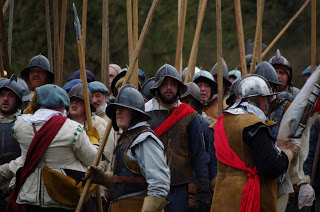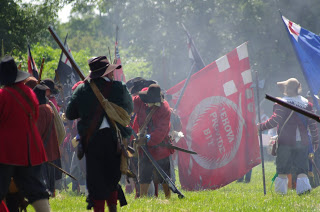The Battle of Preston 17th-19th August 1648
1648, Parliament has Charles imprisoned at Carisbrooke Castle, but secretly the King plots to reclaim his throne by force. He signs a treaty with many of the Scots Covenanters (who now become Engagers) to invade England and join forces with Royalist sympathisers.
It must be noted that the Scottish Kirk did not sanction the Engagement with the King, so the Engager Army was short of many of the most talented and experienced soldiers from the Army of the Covenant.
May 1648, the Engagers rise up and invade England. Royalist risings take place in Kent, Essex and more importantly for the Engagers - Cumberland. A mainly Scottish joint Engager-Royalist army marches south, whilst the New Model Army marches to confront them.
Cromwell's forces mustered the New Model Army and the Northern Association in Yorkshire and marched down the Ribble Valley to meet the Engagers and Royalists at Preston.
The two sides met on Ribbleton Moor on the 17th of August. After vicious, bloody, fighting the New Model Army pushed the Engagers from the Moor.
The Engagers put up valiant stands as they retreated, the most famous in the Preston area being Walton Bridge.
The battle was very one sided, with no quarter given: the New Model Army aggressively pursuing the Engagers. Casualty numbers for the New Model Army were claimed as under 100, whereas approximately 2000 Engager-Royalists were slain and 9000 captured.
Fighting continued, sporadically, for the full length of the retreat down the Wigan Road. By now most of the English Royalists had either been slain or deserted - the Scots were pretty much by themselves.
The Engagers made it to Wigan, where they looked to be making a stand. However the field they chose was felt to be inappropriate for battle so they plundered the town and fled towards Warrington instead. Warrington had a crossing of the Mersey and an escape to Wales where Royalist support could be garnered.
They finally put up a stand in Winwick where they met the New Model Army on the 19th of August. A future ECWtravelogue entry will investigate Winwick and the Museum of Warrington, which has a number of Civil War artefacts in its collection, including what are believed to be frame gun shot.
A sizeable number of Engagers were able to escape the battlefield, making it across the Mersey before eventually surrendering in Uttoxeter on the 25th August.
The continuation of fighting into Wigan and Winwick are considered part of the Battle of Preston, and the dates for the Battle of Preston given as 17th-19th August.
Of those captured many died due to ill treatment during their forced march to ships waiting to take them to servile labour in the New World.
What's there now?
The town of Preston has expanded and the battlefield mostly lost under buildings. The initial site of the engagement at Ribbleton is a housing estate bearing road names named after the commanders of both sides - Langdale, Lambert, Fairfax and Cromwell. There is still an area of greenery, Brookfield Park, by the brook (which supposedly turned red with the blood of the slain), best accessed from Fairfax Road.
On land on the other side of the brook you'll find Cromwell's Mound, a scheduled ancient monument, which was a fieldwork believed to have been used by the New Model Army's artillery. (on Cromwell's right flank).
Park at the new Fulwood Central development (Aldi and B&M - be wary of parking restrictions!), cross the main road at the lights, walk north along the pavement next to the main road for approximately 300 metres where a stile is visible on the other side of the road. Cross the stile and follow the muddy path. The mound is located on your right, effectively behind Aldi.
Having crossed the stile and entered the field, immediately in front of you is a fence line with rough vegetation in front of you, walk to this area (about 10-20 metres from the stile); looking over the barbed wire fence the mound is on the other side of the stream. See the Historic England scheduling page for precise location.
Walton-le-Dale boasts Walton Bridge the scene of bloody fighting, immortalised by Charles Cattermole in his 1877 painting of the Battle of Preston and Walton, which is on display at the Harris Museum in Preston town centre.
In the centre of Preston is the Harris Museum which has a small display about the battle.
Postcodes for SatNavs
Ribbleton Moor, Fairfax Road PR2 6YJ
Cromwell's Mound, parking PR2 9BQ
Cromwell's Mound OS grid reference SD 5428 3382
Walton Bridge & Pinnochio's, Walton-le-Dale PR5 4JA
Harris Museum, Market Square PR1 2PP
It must be noted that the Scottish Kirk did not sanction the Engagement with the King, so the Engager Army was short of many of the most talented and experienced soldiers from the Army of the Covenant.
Cattermole's 'Battle of Preston and Walton', Harris Museum
May 1648, the Engagers rise up and invade England. Royalist risings take place in Kent, Essex and more importantly for the Engagers - Cumberland. A mainly Scottish joint Engager-Royalist army marches south, whilst the New Model Army marches to confront them.
Cromwell's forces mustered the New Model Army and the Northern Association in Yorkshire and marched down the Ribble Valley to meet the Engagers and Royalists at Preston.
The two sides met on Ribbleton Moor on the 17th of August. After vicious, bloody, fighting the New Model Army pushed the Engagers from the Moor.
The Engagers put up valiant stands as they retreated, the most famous in the Preston area being Walton Bridge.
The battle was very one sided, with no quarter given: the New Model Army aggressively pursuing the Engagers. Casualty numbers for the New Model Army were claimed as under 100, whereas approximately 2000 Engager-Royalists were slain and 9000 captured.
Fighting continued, sporadically, for the full length of the retreat down the Wigan Road. By now most of the English Royalists had either been slain or deserted - the Scots were pretty much by themselves.
The Engagers made it to Wigan, where they looked to be making a stand. However the field they chose was felt to be inappropriate for battle so they plundered the town and fled towards Warrington instead. Warrington had a crossing of the Mersey and an escape to Wales where Royalist support could be garnered.
A musket ball from the Battle of Preston, from my own collection
They finally put up a stand in Winwick where they met the New Model Army on the 19th of August. A future ECWtravelogue entry will investigate Winwick and the Museum of Warrington, which has a number of Civil War artefacts in its collection, including what are believed to be frame gun shot.
A sizeable number of Engagers were able to escape the battlefield, making it across the Mersey before eventually surrendering in Uttoxeter on the 25th August.
The continuation of fighting into Wigan and Winwick are considered part of the Battle of Preston, and the dates for the Battle of Preston given as 17th-19th August.
Of those captured many died due to ill treatment during their forced march to ships waiting to take them to servile labour in the New World.
What's there now?
The town of Preston has expanded and the battlefield mostly lost under buildings. The initial site of the engagement at Ribbleton is a housing estate bearing road names named after the commanders of both sides - Langdale, Lambert, Fairfax and Cromwell. There is still an area of greenery, Brookfield Park, by the brook (which supposedly turned red with the blood of the slain), best accessed from Fairfax Road.
The remains of Ribbleton Moor from Fairfax Road
On land on the other side of the brook you'll find Cromwell's Mound, a scheduled ancient monument, which was a fieldwork believed to have been used by the New Model Army's artillery. (on Cromwell's right flank).
Park at the new Fulwood Central development (Aldi and B&M - be wary of parking restrictions!), cross the main road at the lights, walk north along the pavement next to the main road for approximately 300 metres where a stile is visible on the other side of the road. Cross the stile and follow the muddy path. The mound is located on your right, effectively behind Aldi.
Having crossed the stile and entered the field, immediately in front of you is a fence line with rough vegetation in front of you, walk to this area (about 10-20 metres from the stile); looking over the barbed wire fence the mound is on the other side of the stream. See the Historic England scheduling page for precise location.
The green area is Cromwell's Mound, the building in the background is the Fulwood Central development, the stream is between the dead vegetation and the raised green mound.
Walton-le-Dale boasts Walton Bridge the scene of bloody fighting, immortalised by Charles Cattermole in his 1877 painting of the Battle of Preston and Walton, which is on display at the Harris Museum in Preston town centre.
Walton Bridge
Adjacent to the bridge is a building housing Pinnochio's restaurant; which, despite it's appearance, existed during the battle. Cromwell is reported as spending the night there after the first day of fighting.
Pinnochio's
Commemorative plaque at Pinnochio's - this used to be outside, but is now inside due a recent extension 'enclosing' it
A locket bearing the likeness of King Charles
Postcodes for SatNavs
Ribbleton Moor, Fairfax Road PR2 6YJ
Cromwell's Mound, parking PR2 9BQ
Cromwell's Mound OS grid reference SD 5428 3382
Walton Bridge & Pinnochio's, Walton-le-Dale PR5 4JA
Harris Museum, Market Square PR1 2PP
If you enjoyed reading this, or any of the other posts, please consider supporting the blog.
Thanks.















.jfif)





Comments
Post a Comment